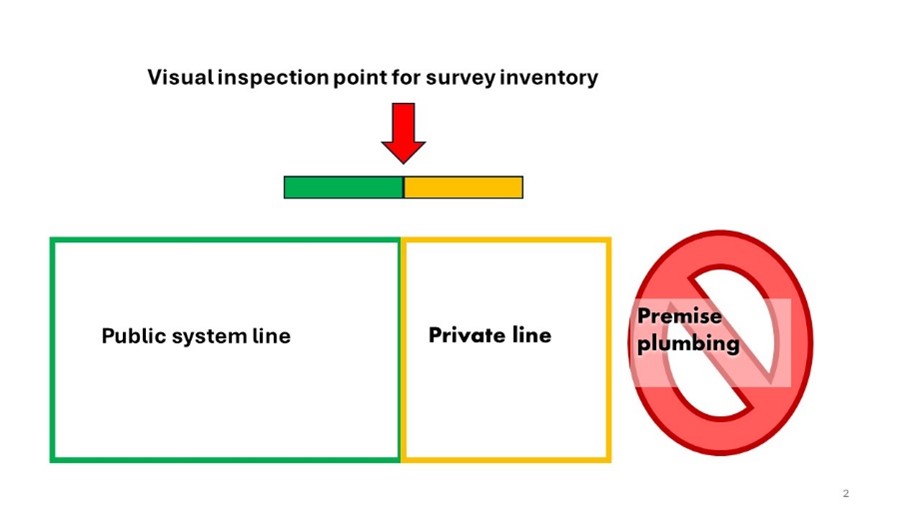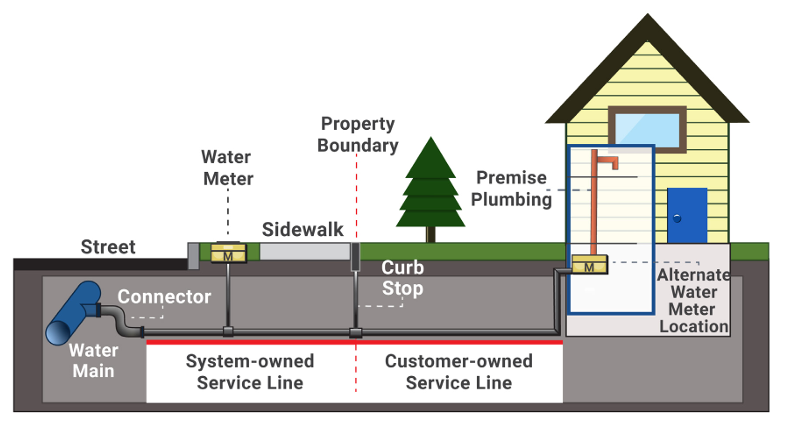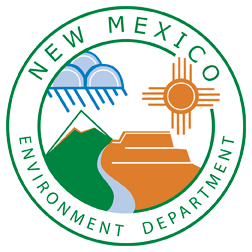Identifying Lead Service Line (LSL) Materials
The LCRR has specific information for identifying service line materials. These service lines may be identified through a number of methods, including but not limited to construction records, water system line repair records, potholing, and hands on inspections of the service line that are easily accessed.
Service Lines are defined as the pipe connecting the water main to the interior plumbing in a building. The service line may be owned wholly by the water system or customer, or in some cases, ownership may be split between the water system and the customer.


An example of a service line. The system-owned portion spans from the water main connector to the property boundary or curb stop. The customer-owned portion is the part of the service line that extends from the curb stop to the meter box or isolation valve in the building’s premise plumbing.
Service Line Inventory Materials Definitions
| Service Line Type | LCRR Definition |
|---|---|
| Lead service line | A portion of pipe that is made of lead, which connects the water main to the building inlet. A lead service line may be owned by the water system, owned by the property owner, or both. For the purposes of this subpart, a galvanized service line is considered a lead service line if it ever was or is currently downstream of any lead service line or service line of unknown material. If the only lead piping serving the home is a lead gooseneck, pigtail, or connector, and it is not a galvanized service line that is considered a lead service line, the service line is not a lead service line. |
| Galvanized Requiring Replacement | A galvanized service line is or was at any time downstream of a lead service line or is currently downstream of a “Lead Status Unknown” service line. If the water system is unable to demonstrate that the galvanized service line was never downstream of a lead service line, it must presume there was an upstream lead service line. |
| Non-Lead Line | The service line is determined through an evidence-based record, method, or technique not to be lead or galvanized requiring replacement. The water system may classify the actual material of the service line (i.e., plastic or copper) as an alternative to classifying it as “Non-lead.” |
| Lead Status Unknown Or Unknown | Where the service line material is not known to be lead, galvanized requiring replacement, or a non-lead service line, such as where there is no documented evidence supporting material classification. The water system may classify the line as “Unknown” as an alternative to classifying it as “Lead Status Unknown,” however, all requirements that apply to “Lead Status Unknown” service lines must also apply to those classified as “Unknown.” Water systems may elect to provide more information regarding their unknown lines as long as the inventory clearly distinguishes unknown service lines from those where the material has been verified through records or inspection. |
| Gooseneck, pigtail, or connector | A short section of piping, typically not exceeding two feet, which can be bent and used for connections between rigid service piping. For purposes of this subpart, lead goosenecks, pigtails, and connectors are not considered to be part of the lead service line but may be required to be replaced. |
| Galvanized service line | Iron or steel piping that has been dipped in zinc to prevent corrosion and rusting. |
Non-Lead Materials
These materials are all considered non-lead for the LCRR inventory requirements. Your system may want to consider including these types as part of its distribution asset management program to plan for future improvement projects. Systems may categorize materials using specific types of non-lead materials instead of the generic non-lead label when doing inventories.
Examples of materials that are considered non-lead include, but are not limited to:
| plastic or polyvinyl chloride (PVC) |
| copper installed before 1986 |
| copper installed after 1986 |
Other Lead Components (pigtails, goosenecks, connectors, etc.)
These components are not considered lead service lines for your inventory. While the systems is conducting it’s inventory it is recommended that if these are found/identified they are documented as part of a long term asset management plan. The Lead and Copper Rule Revisions require that the water system must replace any lead gooseneck, pigtail, or connector it owns when discovered during water system infrastructure work. The water system must offer to replace a customer-owned lead gooseneck, pigtail, or connector; however, the water system is not required to bear the cost of replacement of the customer-owned parts. The water system is not required to replace a customer-owned lead gooseneck, pigtail, or connector if the customer objects to its replacement.
Return to Lead and Copper Rule Revision

